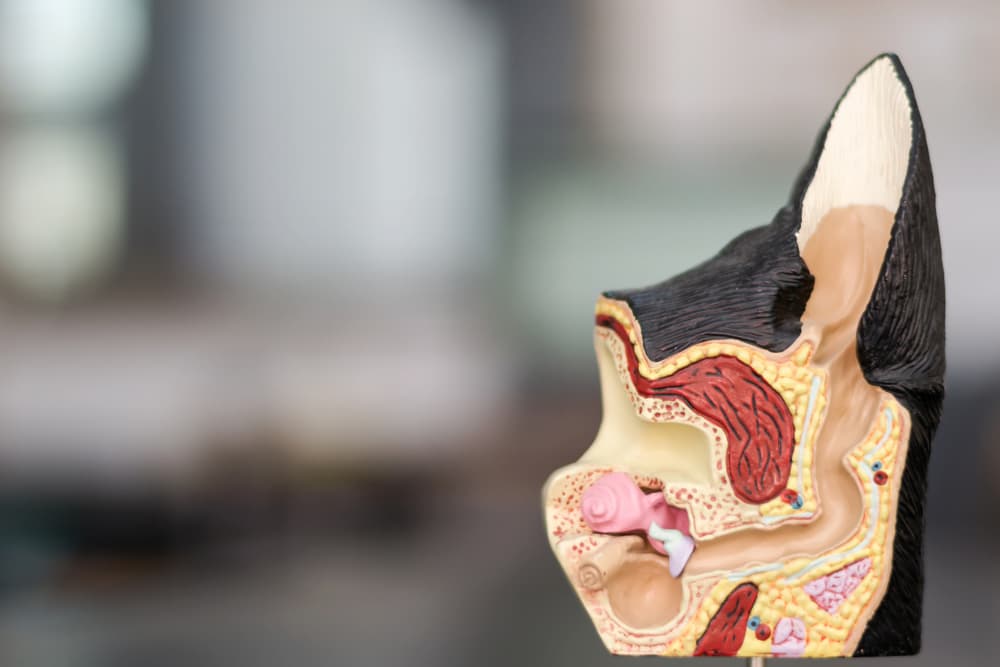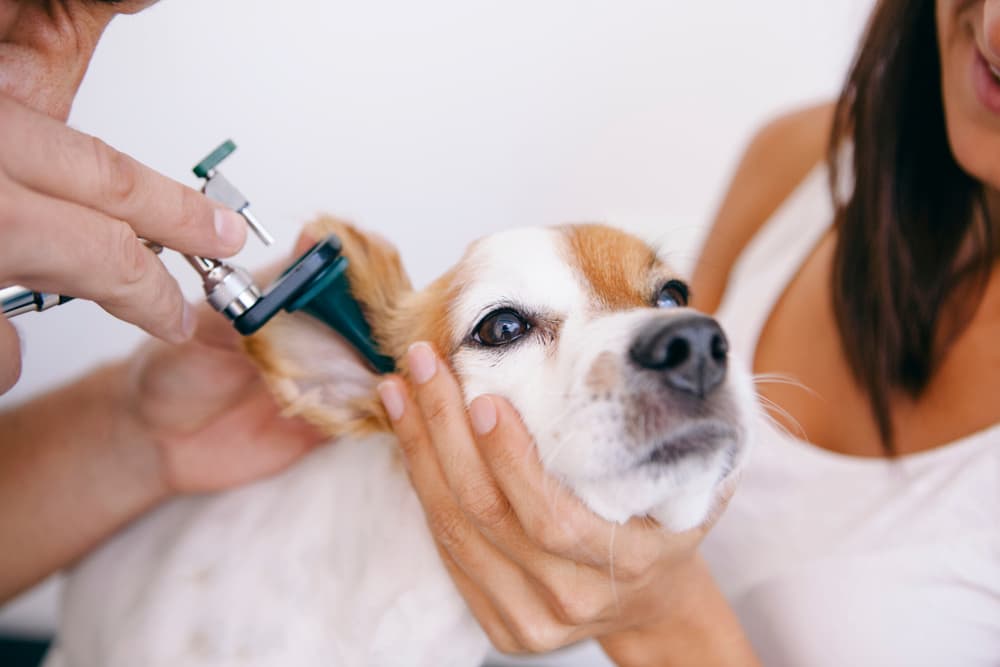6 Signs of Ear Infection in Dogs
Reviewed by Catherine Barnette, DVM. Updated on September 25, 2024

The signs of ear infection are something all pet parents should know. Ear infections can cause our canine friends a lot of discomfort — and they’re a very common health condition. From noticing your dog whining to shaking their head more than usual, there are a few telltale dog ear infection signs to look out for.
Regularly cleaning your dog’s ears at home can help reduce the risk of ear infections. But if you’re concerned about your dog’s ears, it’s important to ask your vet for advice as soon as possible before a potential infection gets worse.
Read on to find out why dog ear infections happen in the first place, how to tell if a dog’s ears may be infected, and ways to keep your canine companion’s ears as healthy as possible.
All featured products are chosen at the discretion of the Vetstreet editorial team and do not reflect a direct endorsement by the author. However, Vetstreet may make a small affiliate commission if you click through and make a purchase.
What Causes Ear Infections in Dogs?

The shape of a dog’s ear canal makes them more prone to developing infections than their human counterparts. While our ear canal is relatively straight, a dog’s is shaped like an L. This creates an area where fluid can collect — creating the perfect environment for bacteria, yeast, or fungus to thrive.
Dog ear infections tend to fall into three categories:
- Otitis externa: Affects the external ear canal
- Otitis media: Occurs within the middle ear
- Otitis interna: Occurs within the inner ear
The most common type of ear infection in dogs is otitis externa, which is usually easily treated. But if left untreated, it can develop into otitis media or otitis interna. Middle and inner ear infections tend to be a lot more serious and painful, requiring more extensive treatment.
Dog ear infections can be caused by a range of factors, including:
- Parasites: Ear mites, ticks, and the mites that cause mange can be the cause of an ear infection in dogs. Infections due to ear mites are more common in puppies than in older dogs.
- Foreign bodies: This is anything that gets into your dog’s ear that shouldn’t be there. Common examples include grass awns or sand that then cause inflammation, allowing an infection to take hold.
- Bacteria: Many different species of bacteria, including Staphylococcus, can trigger ear infections, usually when a dog’s ear is already compromised, through excessive moisture or inflammation.
- Fungus or yeast infections: Yeast occurs naturally on your dog’s skin, but this is another common cause of ear infections if a dog’s ear is compromised.
- Allergies: Dogs with allergies, whether to food, fleas, or something else, are often more likely to suffer from ear infections as well.
- Conformation: Dogs with long, pendulous ears are at higher risk of ear infections. So are dogs with excessive hair within the ear canal. Both of these issues can create moist conditions where bacteria or yeast can thrive.
- Tumors: Both benign and malignant tumors can trigger inflammation and ear infections.
- Excessive moisture: Swimmer’s ear can be a problem in dogs who spend a lot of time in the water.
- Health conditions: Ear infections can be caused by a range of health conditions, including autoimmune, endocrine, and keratinization disorders.
- Idiopathic: If your dog suffers from persistent ear infections that have been investigated by your vet but no obvious cause is found, it is considered idiopathic.
Some dogs can suffer from chronic otitis, a long-lasting ear infection that can cause serious harm.
Your dog’s breed can also play a role in whether they are more prone to ear issues. “Long floppy ear breeds and those with excessive hair in the outer ear canals are the breeds most susceptible to ear infections,” explained Dr. Fleck, DVM and co-host of The Pet Buzz.
Research has found that the breeds most susceptible to ear infections include:
But any dog with long, floppy ear flaps will tend to be at a higher risk of ear infections than dogs with pointy ears.
6 Signs of Ear Infection in Dogs

So, what are some warning signs of ear infections in dogs? Sometimes, changes in your dog’s behavior will be easy to pick up on, and other times you might not notice anything is wrong with your pet. Here are six common signs of ear infections in dogs to watch for:
1. Head shaking
If your dog has long ears, you might have come to love the distinctive sound of their floppy ear shake — but excessive head-shaking can be a sign of an ear infection. If your dog can’t stop shaking their head, give their ears a closer look.
2. Scratching and rubbing
Ear infections can make a dog’s ears very itchy. In an attempt to soothe this, your dog might scratch their ears with a paw or rub their heads along the wall or floor. You might also hear your dog crying or whimpering as they rub their ears.
3. Inflammation or swelling
A dog’s ears may become inflamed, swollen, and hot to the touch. In extreme cases, your dog may get a hematoma (a blood collection under the skin), which will result in extreme swelling.
4. Excessive ear wax
A little ear wax is normal for dogs, and it’s usually light brown or yellow in appearance. Other ear wax colors, such as gray, green, dark brown, black, or red, can indicate an infection.
5. Pungent odor
All dogs can be a little stinky at times, but if you notice your dog’s ears are particularly smelly, this can be a sign of infection.
6. Pain
Dogs can be really good at hiding pain, so you might not initially notice a dog with an ear infection is uncomfortable. If your dog usually enjoys a good ear rub and suddenly doesn’t want their ears touched or shows signs of aggression when touched, they might be suffering from a painful ear infection.
Dog Ear Infection: Next Steps

If you notice signs of a dog ear infection, contact your veterinarian as soon as possible, Dr. Fleck says. If you can’t schedule an immediate appointment, there are some steps you can take at home while you wait. “Cleaning the debris on the surface of the ear flap with a pet ear cleaner a couple of times a day will help,” Dr. Fleck says.
A good ear cleaner for dogs, like Silver Honey® Rapid Ear Care Vet Strength Ear Rinse, can help soothe irritation and inflammation while also removing debris, dirt, and wax. “This step should never be a substitute for veterinary advice,” Dr. Fleck explains, but it can help make your dog feel a little more comfortable in the meantime.
There are over-the-counter products available for treating ear issues in dogs, but Dr. Fleck advises speaking with a veterinarian first to determine the best course of action for your pet. “Effective, safe application and treatment protocols will always come from the veterinarian,” she says. This includes cleaning instructions and when prescription medications are needed.
To determine what’s causing your dog’s ear issues, your veterinarian will examine your dog’s ears, including looking within the ear canal itself. Sometimes, the cause will be obvious — like a grass awn. Other times, your veterinarian may need to run diagnostic tests to check for ear mites, fungus, or bacteria.
Some dogs may need to be sedated during the exam so the veterinarian can more easily collect a sample from the ear and clean out the ear canal.
The type of medication your vet recommends will depend on what’s causing your dog’s ear infection and how severe it is.
How to Prevent Ear Infections in Dogs
To lower your dog’s risk of ear infections, there are a few steps you can take at home. First, get into the habit of regularly checking your dog’s ears and watching for signs of infection. If your dog has floppy ears, lift their ear flap and check the visible section of their ear canal.
“Proper ear cleaning is recommended twice weekly for vulnerable breeds,” Dr. Fleck says. Use a product recommended by your veterinarian, like Silver Honey® Rapid Ear Care Vet Strength Ear Rinse. “Closely follow the technique demonstrated at your veterinary office,” Dr. Fleck says. You can combine these cleaning sessions with a quick check of your dog’s ears. Don’t clean your dog’s ears more often than recommended by your veterinarian, and avoid using cotton swabs or anything that can push debris into your dog’s ears or damage their eardrum if used incorrectly. Dog ear wipes, such as Silver Honey Rapid Ear Care Pet Wipes, can be wrapped around your finger to gently remove debris from the outer ear before it enters the ear canal.
If your dog has hair inside their ears, ask your veterinarian for advice. “Trimming or removing hair from the ear canal should be done by a professional groomer or veterinary office using proper hair extraction equipment,” Dr. Fleck says.
If your dog’s ear infections are triggered by swimmer’s ear and excessive moisture, talk to your veterinarian about how to keep your dog’s ears as dry as possible. “Apply ear cleaner after leaving the pool, lake, or ocean,” Dr. Fleck recommends.
By checking and cleaning your dog’s ears regularly, you can help protect them against ear infections. If they still deal with ear issues despite your best efforts, at least you’ll feel more prepared to take quick action.
Pet Health Insurance Can Help
Unexpected veterinary bills can make caring for your pet challenging. Don’t let financial stress get in the way of making the best decisions for your pet. Pet health insurance can cover surprise costs such as veterinary visits, prescription medications, and life-saving procedures.
Review personalized options for your pet below:

